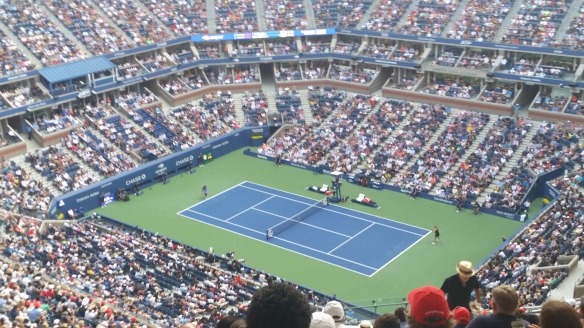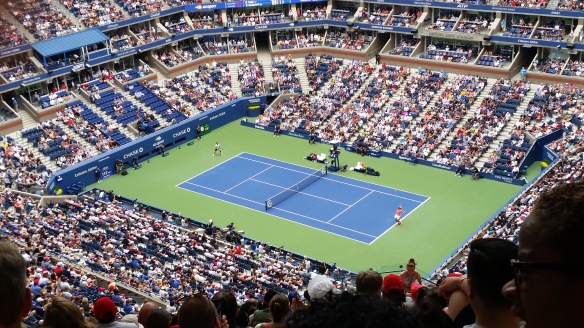
Serena (left) serving to Kaia Kanepi
The twin billing for the US Open Day Session held on September 2, 2018, at Arthur Ashe Stadium seemed like it was plucked from a fantasy lineup. Men’s World Number One Rafael Nadal kicked things off against Nikoloz Basilashvili in a Round of 16 match. Former Women’s World Number One—former only because she took a year off for maternity leave—Serena Williams took on Round of 16 opponent Kaia Kapeni in the main event.
Two superstars in Nadal and Serena, plying their craft back-to-back on the biggest stage in tennis. And I had one of the 23,771 golden tickets—all the way up in the nose bleeds of Row W—to see these greats in action.
Nadal’s 6-3, 6-3, 6-7(6), 6-4 victory over Basilahsvili was a stroll in the park for the Spaniard through the first two sets. Nadal, playing in a sleeveless electric orange top that made him look like a highlighter from my perch up top, held all his serves in the first two sets, content to keep the ball in play and let Basilashvili make mistakes that cost the Georgian valuable points. Basilashvili racked up 23 unforced errors to Nadal’s 8 through those first two sets.
One unforced error in particular summed up Basilashvili’s first two sets. The Georgian pinned Nadal into the tough spot of lobbing the ball back to him. Basilashvili hit an overhead smash—but Nadal returned that smash with another lob. Again, Basilashvili hit an overhead smash—and again, Nadal lobbed the ball back. On this third lob, Basilashvili, running inside the service box now, smashed that ball hard this time around.
But the ball zipped downward too early and crashed into the net. You could feel the crowd wince when the ball hit the meshing.
“Dude.” I blurted out loud when Basilashvili botched the freebie. But in the long run, this was for the best. The quicker Nadal won this match, the sooner Serena could stop on court to play—the first time I’d get to see the most decorated active player in tennis.
If only things were that straightforward.
Instead, the chair umpire seemed to stoke a fire within Basilashvili in the third set.
This year’s US Open was not only the 50th edition of this Grand Slam, but also the first Slam to implement the Serve Clock. The Serve Clock grants the server 25 seconds to initiate a serve from the end of the last point, but the Chair Umpire has some leeway to enforce that (e.g., ballkids using up some of that time to shuffle around the court because of a stray ball).
Halfway through the third set, the Chair Umpire called Basilashvili for a Serve Clock violation right when he was about to toss the ball, and Nadal incurred the subsequent wrath. Basilavhili shortened points into 2-3 shot rallies by taking every opportunity he had to blast opposite court rockets past Nadal. If Nadal was on the left, Basilashvili let loose to send the ball to the right, the ball always kissing the sideline to stay in. Those ambitious shots usually strayed wide for Basilashvili in the first two sets. An emboldened lone Basilashvili fan seated in the section to my right began shouting for him in between points when Basilashvili was rolling here.
Even though Nadal held serve the rest of the third set, Basilashvili could do no wrong. The Georgian pummeled the Spaniard with 23 winners in the third set—Basilashvili combined for 33 winnners in the other three sets—en route to sealing the third set in the tiebreak.
Despite Basilashvili’s surge in the third set, Nadal held firm with playing defensively from the baseline. Thankfully for Nadal and those in the sweaty crowd waiting for Serena, Basilashvili regressed to his norm in the fourth set. At 3-3, Nadal broke Basilashvili with the help of three unforced errors from the latter, consolidated the break, then defeated Basilashvili in his next service game with an ace.
Love you, Nadal, but your 3+ hour match was a long wait for Serena. But right away, Serena made it worth the wait.

Nadal (right) serving to Basilashvili
Regal is the best adjective to describe Serena on that Sunday afternoon. She earned that aura through her dominance of the game, her longevity, and her comeback to the sport as a mother navigating that seesaw between family and career. The lavender tutu Serena wore for this match—purple being the color of royalty—was the perfect uniform to symbolize the outstanding career she has had so far.
Each set in Serena’s 6-0, 4-6, 6-3 victory over Estonia’s Kaia Kanepi had its own distinct tone and rhythm. The first set shall be dubbed “Serena: The Invincible”. In a mere 18 minutes—some people take showers that last longer than this—Serena blanked Kanepi 6-0 using every weapon in her arsenal. She blasted the ball past Kanepi to rack up most of her 14 winners in this set. She flashed some finesse by attacking the net and winding up for another powerful forehand, only to manipulate her arm at the moment of contact between ball and racket to strike a drop shot for a winner. And, of course, Serena dished out aces. Four of them in this set—including three consecutive aces that won the set for her 6-0.
“She’s too good,” said the woman in front of me about Serena, with a tone of approval. The man seated to her left could only shake his head in disbelief at the dismantling he just witnessed.
However, the second set shall be dubbed “Serena: The Human.” Kanepi stepped up the aggression in play and shortened rallies for quick points, similarly to what Basilashvili did to take the third set off Nadal. Serena compounded her problems with a lack of shot control, hitting 13 unforced errors and two double faults in the face of Kanepi’s pressure. It got so bad for Serena that Kanepi powered her way to a double break at 5-2. Serena regained her footing and clawed back a break, delivering a rousing “COME ON!” to stoke the fire of this comeback. It’d be too little, too late for her to rescue the set, though, and Kanepi claimed it at 6-4.
Throughout the second set, even when Serena played poorly and fell behind, there was a palpable sense of confidence within the crowd that she would pull through in and right the ship. The mindset was probably that she’s Serena—she’ll get over this soon. And soon would be this point, and if not, then this game, and if not, then this set. Soon. The crowd rallied for Serena when she fell behind in the double break, but nothing could stem her erratic hitting until late in the set.
The little revival Serena had when she took back one break in the second set laid the groundwork for the final set, which shall be dubbed ‘Serena: The Triumphant”. The momentum from reclaiming a break carried into the third set, with Serena racing to a 3-0 lead. All systems were firing as normal again.
As Serena found the winners again with her variety of shots, the jitters that plagued Kanepi in the first set resurfaced at the worst possible time for her. When Serena broke to go up 2-0, Kanepi hit four unforced errors.
The crowd followed Serena’s resurgence and got rowdy like it was a night session at Ashe. Serena rewarded the crowd with a lot to cheer about: 16 winners for the set and 8 aces in her five service games. Serena served up consecutive two aces on two occasions (including hitting an ace to end her fourth service game and kicking off the fifth with an ace), and three of those five service games featured two aces. That’s Serena’s way of shortening points and the crowd lapped it all up.
Serena’s final service game to close out the match featured a solitary ace, but she capped off the victory with a forehand winner that brought the crowd to its feet. She did her signature twirl to say thanks and farewell to the crowd, conducted the postgame interview and Emirates Airlines promotion of hitting three signed tennis balls into the crowd, then exited the court. My day with tennis royalty—starring Nadal as a prince and Serena as the Queen—was over.
